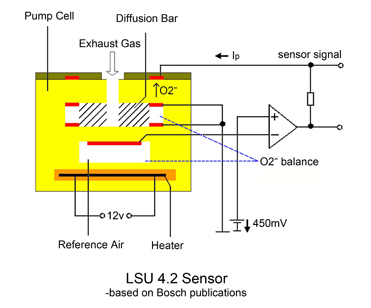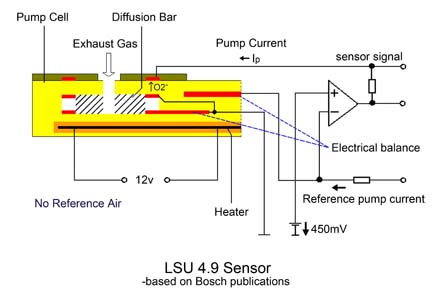|
This article was first written in 2009. Back then, the LSU4.9 sensor was still new. Most wideband controllers in the market only supported LSU4.2 sensors, and there were so many people doubting the advantages of LSU4.9 over LSU4.2. Now it is clear that the new technology IS better than the old. Should we say that LSU ADV sensor is even better than LSU4.9? We do know that LSU ADV is evolved from LSU4.9, inheriting all the advantages of LSU4.9 and improved the robustness more. This is the fundamental difference between the LSU 4.2 and LSU 4.9. LSU 4.9 gets rid of the reference air, and therefore gets rid of the biggest failure mode. As a result, LSU 4.9 has a long life and can maintain the accuracy throughout the life. Only since then, Bosch LSU sensors have been used widely in the auto industries. Most aftermarket wideband controllers are still using LSU 4.2, mainly for easy access. Bosch sells the LSU 4.2 to the aftermarket at a lower price than LSU 4.9. Plus, many of those companies do not want to or are not able to adapt the new LSU 4.9 sensors. There is a big mis-understanding that LSU 4.9 is only for diesel engines, because it can measure very lean AFRs. That’s not true. There is a diesel version of LSU 4.9, called LSU4.9D, mainly because of fuel and temperature difference. LSU 4.9 has been widely used with the gasoline engines. In fact, it is the most popular gasoline engine O2 sensor now, not only because it measures wide range of AFR, but also because it has the very good reliability, and high accuracy. There are a few wideband controller companies in the aftermarket using LSU 4.9. But that does not mean all controllers using LSU 4.9 are equal. Even with the same LSU 4.9 sensor, the controller can make a big difference. Some wideband controllers are designed for AFR display only, and they are named as “wideband AFR gauges” instead of controllers. You can imagine that those wideband gauges do not have good accuracy and fast response rate because they are not designed for those purposes. Those gauges are more for good looking than for engine tuning purposes. For engine controls, the accuracy and response rate are the most critical characteristics of a wideband controller. One way to tell whether a wideband controller is good or not, is to see whether it can be used as a feedback device for the ECU. A feedback device must provide a real-time signal in the fast rate and high accuracy, even under dynamic situations. The requirements for a feedback device are much, much more than those for a gauge. Even with a LSU 4.2, the controller makes a big difference. Bosch sensors are not easy to fail even with a LSU 4.2, if controlled appropriately. Especially, LSU 4.9 is designed for more than 10 year life because it has to, for the vehicle life. It should not fail in short time, like a couple of years. Many OEM cars have been running with LSU 4.9 for years and we have not heard any recalls because of LSU4.9 sensors. Why do so many aftermarket wideband systems have failed LSU sensors? Because many of them don’t have a good heating control strategy. Furthermore, the accuracy of LSU sensors is highly dependent on the operating temperature of the sensing element. The sensor reading can be very different if the temperature of the sensing element is different. LSU sensors must work at the vicinity of certain temperatures for the good accuracy. LSU4.9 sensor must be maintained at 780 degrees Celsius precisely. Bosch CJ125 chip is designed for this task. The heating strategy is a close loop control based on the measured sensor temperature. PLus, LSU 4.9 has a much higher sensor temperature resolution because of the resistance characteristics, so the heater controls are much better than LSU 4.2. As a result, 4.9 has a longer life and better accuracy. In every Bosch LSU sensor data sheet (4.2, 4.9 or ADV), it is clearly stated:”The wide band sensor LSU operates only in combination with a special LSU control unit (CJ125 ASIC). The functional characteristics given in this document are only valid for operation with the CJ125 according to module specification and with recommended operational parameters.” Bosch means it. Anybody who tried to design a cheaper circuit and claimed it better ended up with a less quality one! Because Bosch simply had done that to the extreme. The cost in auto industry is everything. If there would have been a way to save another penny in the sensor control circuit, Bosch would have done it with the CJ125 chip. If some after-market vendors could design a better control circuit to control the LSU sensor and it would be cheaper, they could sell that “invention” to Bosch. Instead of re-inventing the wheel, Ecotrons use CJ125 in every ALM controller. Because we are from the auto industry and we have the professional experience of LSU sensor controls, we know how to utilize every bit of the advantages of the genuine CJ125 chip. In short, not only the sensor LSU 4.9 is superior to 4.2; but also the controller with a CJ125 chip makes it an OE equivalent system. If you are still not sure, you can use an oscilloscope to actually measure the analog outputs of different wideband controllers if you really want to see the difference. Data do not lie. More info on LSU4.9 vs. LSU4.2 What makes LSU 4.9 superior to LSU 4.2 is not only because LSU 4.9 uses an electrical reference signal, and LSU 4.2 uses the reference air, but also because Bosch significantly improved every aspect of the LSU sensor in the 4.9 version, and made it a mass production level, with superior reliability and quality. Once again, with LSU 4.9, Bosch has dominated the oxygen sensor market in the automotive industry as it did before. Below are some of major improvements of LSU 4.9: 1) Thinner sensing element. All LSU sensors use thick-film technology, which means the whole sensing element is composed of a bunch of thin layers made of different materials. LSU 4.2 has a total thickness of the sensing element as 1.5mm (1 mm = 0.04 inches), while LSU 4.9 is only half of that. How significant is this? Think about this: there are about 10 layers of materials in the sensing element, you squeeze them into 1.5mm thickness. Already hard to imagine? then you have to cut it to half for LSU 4.9. This is the most significant reason that why LSU 4.9 is more expensive than LSU 4.2. Because everything that is used to manufacture the LSU 4.2 sensors has to theoretically double the precision to make LSU 4.9! What are the benefits? more accurate measurements and faster response! Even common sense tells you, when the electronics become smaller and smaller, they tend to be more sensitive and respond faster! 2) New design of protection tubes. The sensing element is protected by a double layer tube. LSU 4.9 has a new design of the inner tube. It has a sophisticated structure to create gas rotations around the sensing element, and it also blocks the liquid droplets reaching the sensing element. What are the benefits? improved gas flow, faster dynamic response and significantly reduced thermal shock risk. Especially the latter one, that thermal shock has been the number one enemy of the oxygen sensor all the time. By fixing this problem, Bosch fundamentally made LSU 4.9 sensors to the mass production level for auto industries. In auto industries, all parts must be designed for at least 10 year life. The LSU sensor is the most important emission control device. It must sustain the harsh environment for 10 years or more. Since 2007, many GM, Ford and other OEM vehicles have been equipped with LSU 4.9 sensors to meet the recent stringent emission requirements. Most likely your vehicle has one LSU 4.9 at least, some have 2 or more. And most likely none of them has been broken. Otherwise you will see the “check engine” light ON on the dash the first thing. 3) Measuring the internal resistance and close loop control of the sensor temperature. This is done with the CJ125 chip. We know the temperature of the LSU sensor has big impact on the accuracy and response speed. In fact, LSU sensor only works well at the vicinity of certain temperature. For LSU 4.9, it is 780 Celsius. Bosch factory calibration and sensor characteristic data are done based on this temperature. If your controller can not maintain the sensor temperature around 780 C, the sensor reading can be significantly skewed. With a CJ125 chip, you can measure the internal resistance of the sensor, which is the direct reflection of the sensor temperature, and use it as the feedback to control the sensor temperature in a close-loop manner. Only by controlling the sensor temperature in the close-loop mode can you make the LSU sensor accurate. Next time, when you buy a wideband controller, ask your vendor: “can your controller do close-loop control of the sensor temperature? Can your controller show the real-time sensor temperature so I can see it?” There are many other advantages of LSU 4.9 sensors over 4.2 ones. But not all people are interested in too much technical detail. You can use common sense then. Why GM, Ford and other car manufacturers all use LSU 4.9, not LSU 4.2? If LSU 4.2 were very close to 4.9 and it is much cheaper, why wouldn’t they just use 4.2? It would generate a lot more profits. If LSU 4.2 were able to do the same job, why Bosch would even bother to spend a lot of money to develop new ones? In the auto industry, ETAS lambda meters are the widely used professional wideband controller. They are used exclusively with LSU 4.9 sensors, though they do support 4.2. But nobody would use an ETAS lambda meter with a LSU 4.2. By the way, ETAS is majority-owned by Bosch. LSU 4.9 has become a mass production auto part. It is not a luxury part any more. It is available to aftermarket already. Yes, it is more expensive than LSU 4.2, but the benefits of 4.9 worth much more than the price difference. For engine tuning, every bit of the accuracy gain of the sensor can save you tons of hours of tuning time.
A little more on ALM Besides air/fuel ratio measurement, ALM provides some supplemental functions which make your measurement or tuning more convenient: linear analog output to your ECU or gauge; LED digital display; engine RPM probe, other analog sensor inputs like MAP and/or exhaust gas temperature (EGT); data logging with a serial communication to a PC, etc |





